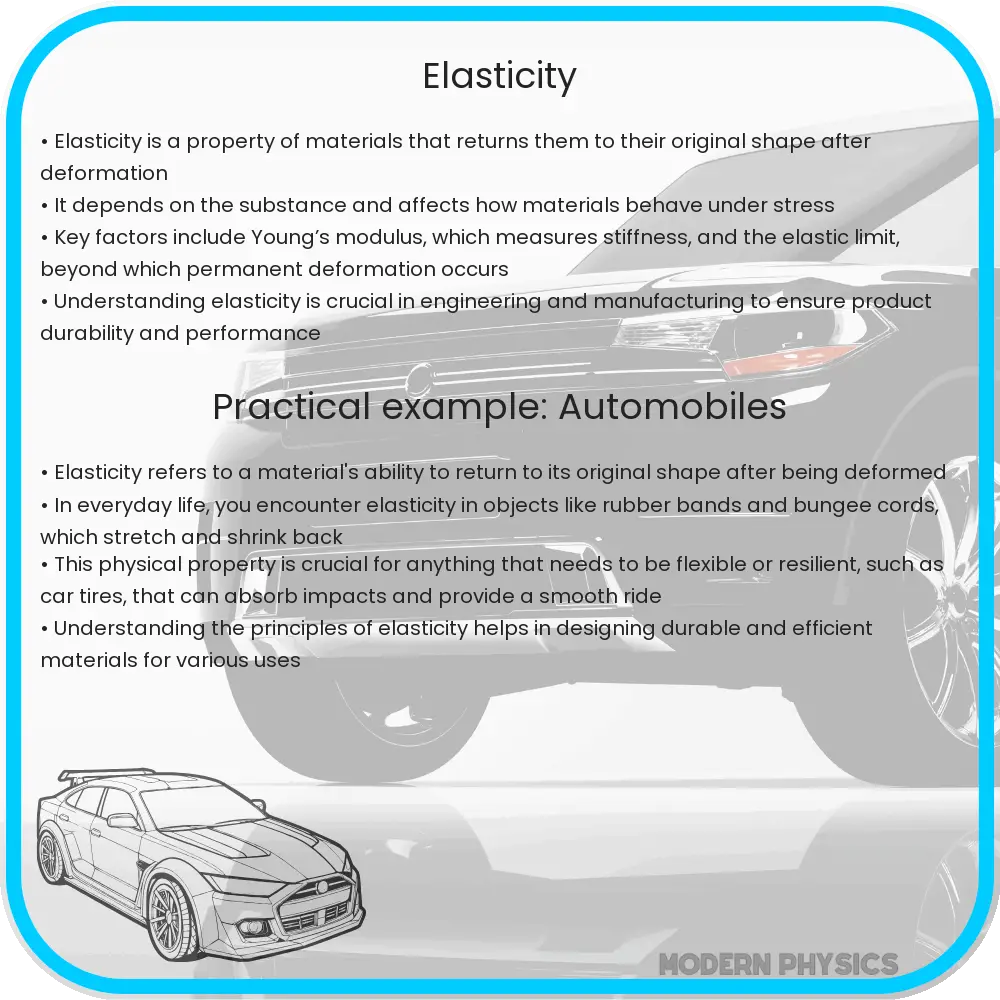Explore the fundamentals of elasticity in dynamics, covering stress-strain relationships, elastic moduli, and the impact of forces on materials.

Understanding Elasticity in Dynamics: Stress-Strain Relationships and Moduli
Elasticity is a fundamental concept in the study of dynamics, particularly in the fields of physics and engineering. It describes the ability of a material to resist deformation under applied forces and then return to its original shape once these forces are removed. This property is critical in numerous applications, from designing buildings and bridges to creating everyday products like car tires and electronics.
At the heart of understanding elasticity lies the stress-strain relationship. Stress (σ) is defined as the force applied per unit area, often expressed in Pascals (Pa), and strain (ε) is the deformation experienced by the material, a dimensionless quantity representing the relative displacement between particles in the material. Mathematically, stress (σ) is given by:
σ = F/A
Where F is the force applied and A is the area over which the force is distributed. Strain (ε), on the other hand, is calculated as:
ε = ΔL/L0
Here, ΔL is the change in length and L0 is the original length of the material. The stress-strain curve, which plots stress (σ) against strain (ε), is crucial for determining the elasticity of a material.
The Role of Elastic Moduli
Elastic moduli, such as Young’s modulus (E), Shear modulus (G), and Bulk modulus (K), are measures of the stiffness of a material. They are intrinsic properties that dictate how much a material will deform under applied stress. Young’s modulus, for instance, is a measure of the stiffness of a solid material. It’s defined as the ratio of stress to strain in the linear portion of the stress-strain curve:
E = σ/ε
Shear modulus and Bulk modulus follow similar definitions but are used for different types of deformations. Shear modulus applies to shear stress (force applied parallel to the surface), and Bulk modulus applies to volumetric stress (force applied uniformly in all directions).
Understanding these moduli is crucial in material science for selecting appropriate materials for specific applications. A material with a high Young’s modulus, for example, would be chosen for applications requiring high stiffness and minimal deformation under stress, like in building supports or aircraft design.
Forces and their effects on materials are central to the concept of elasticity. Newton’s laws of motion and equilibrium conditions are applied to understand how forces lead to stress and strain in materials. These principles help engineers and scientists predict how materials will behave under various load conditions, ensuring safety and efficiency in design and application.
Forces and Their Effects in Elasticity
Forces play a pivotal role in the dynamics of elasticity. When an external force is applied to a material, it results in either stretching, compression, or shear, depending on the nature and direction of the force. This deformation leads to stress within the material. The relationship between the applied force and the resulting deformation is governed by Hooke’s Law in the elastic region, which states:
F = -kx
Here, F is the force exerted, k is the spring constant (a measure of the stiffness of the spring), and x is the displacement from the equilibrium position. Hooke’s Law is fundamental in understanding the behavior of materials under elastic deformation.
Real-World Applications and Limitations
Elasticity finds practical applications in various fields. In civil engineering, it helps in designing structures that can withstand forces like wind and earthquakes without permanent deformation. In the automotive industry, the understanding of material elasticity is crucial for designing components that can absorb impact in the event of a crash. Similarly, in biomechanics, elasticity helps in understanding and replicating the behavior of human tissues and organs for medical implants and prosthetics.
However, it’s essential to note that the elastic behavior of materials has its limitations. Beyond a certain point, known as the yield strength, materials will undergo plastic deformation, where they do not return to their original shape after the removal of the force. This behavior is described by the stress-strain curve beyond the elastic limit, leading to a permanent change in the material’s structure.
Conclusion
The study of elasticity in dynamics encompasses the intricate balance between forces, stress, and strain, and how materials respond to these factors. Through the principles of stress-strain relationships, elastic moduli, and the application of forces, we gain insights into the behavior of materials under various conditions. This understanding is crucial for designing safe, efficient, and innovative solutions in engineering, architecture, and other applied sciences. While elasticity provides a robust framework for understanding material behavior, it is also important to recognize its limitations, especially when dealing with real-world applications where materials might experience forces beyond their elastic limits.
In conclusion, the exploration of elasticity is not just a theoretical pursuit but a practical one, laying the groundwork for advancements in technology and contributing significantly to the development of sustainable and resilient structures and systems in our ever-evolving world.
